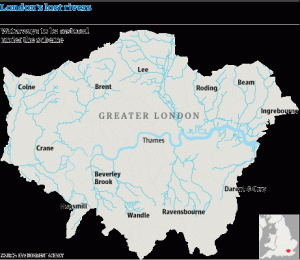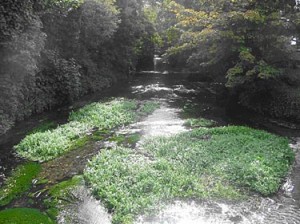project launched to breathe life into waterways buried under London concrete and brick
• Environment Agency plan to restore 14 channels
• Stretch of 15km could take six years to uncover
the article below was written by Juliette Jowit for The Guardian last week.
They are Britain’s “lost rivers”, which for centuries have been used as open drains, covered in concrete, hidden behind high walls and even built over. The list includes some of the most famous place names in Britain, though few people know they once referred to a waterway: the Fleet, the Strand and the Tyburn.
Now one of the biggest rescue projects of its kind is being launched today to reclaim many urban rivers, streams and brooks. Under the plan 92 projects will be announced covering 14 different waterways in London, at least seven of which have been buried by history, including the Effra, which rises in Crystal Palace and flows north to the Thames at Vauxhall, the Ravensbourne in south-east London, the Wandle in Croydon, and two tributaries of the Lee near the 2012 Olympic site in east London.
The Environment Agency, which will lead the work, hopes to uncover at least 15km (nine miles) of river in the next six years. The full list adds up to double that length, while other schemes are still being proposed. “It took 50 years to destroy a lot of the value of the rivers in London – it’s going to take another 50 years to get it back,” said Dave Webb, the agency’s project manager.
Humans began interfering with Britain’s rivers over a millennium ago with watermills and fisheries. As cities became more crowded, waterways became little better than open drains and developers gratefully covered them over for roads and buildings, a practice that spread to the suburbs through much of the 1900s.
Today the Environment Agency estimates that 70% of London’s 600km river network is concreted, covered over, interrupted by weirs or otherwise modified. Some can only be glimpsed in odd places, such as a tunnel through Sloane Square tube station carrying the Westbourne, or guessed at from local road names such as Fleet Street or Spring Path.
During the 20th century huge improvements were made to water quality, but the lack of natural features to offer cover for wildlife means the rivers are often still “ecologically poor”, said Webb.
At the most extreme, up to half of some rivers are now entirely buried. Many others are often hidden by high fences or are so barren of natural life that they are effectively “lost to society”, said Webb. “Any connection or added value of a river has been lost … people see a concrete channel and don’t think of it as a river: they think of it as a drain, which is a way of getting rid of waste.”
Restoration of London’s rivers began in the mid-1980s; since then 15km have been completed. Full restoration – meaning restoration of “physical and biological processes” – of some stretches has included the recovery of the once-lost Quaggy river through Sutcliffe Park in south-east London. The park was also restored as a flood plain to protect local homes and businesses in the event of heavy rains. Other projects are defined as “rehabilitation”, usually adding natural features such as gravels or reed beds into the existing modified channel.
The next phase will speed up the rate of restoration, and target tougher schemes in built-up and often socially deprived areas. Many projects will also incorporate improved flood defences to cope with climate change, habitat schemes and urban regeneration along with features to encourage local people to use parks more, including dipping ponds and education areas.
Other rivers that will benefit include the Brent near Brent Cross shopping centre in north London, the Hogsmill near Kingston, and parts of the Thames near Hampton Court.
The agency hopes it can later extend the work to urban rivers outside London, but is pessimistic that parts of the Fleet might one day be released to public view.
Costs can be as much as £500,000 a kilometer, though they are often lower, and are paid for by the agency, environment charities and private developers.
The agency believes recent restorations have attracted more visitors to riverbanks and nearby parks, as well as leading to a reduction in antisocial behaviour, the return of fish such as chub and dace, and birdlife, such as kingfishers.
Future success will be measured by the return of wildlife and visitors, said Webb, who trained as an ecologist. “With any part of a river you should have a reasonable chance of seeing a fish, maybe a kingfisher … you should want to stop and stand and look at a river for 10 minutes,” he said. “If the river is so boring that you wouldn’t want to do that, then [it’s] in a bad way, and unfortunately that’s where we are on some rivers.”
There is probably no time in recorded history when London’s waterways were not altered by human activity: the Domesday book of 1086 records more than 6,000 mills and freshwater fisheries on the capital’s rivers, streams and brooks. Burying rivers began in medieval times, as many had become dumping grounds for rubbish and sewage, causing blocked channels to flood and had generally become “an eye-sore and a nose-sore”, said Nicholas Barton, author of the book London’s Lost Rivers. One of the biggest tributaries of the Thames, the Fleet, was covered over during the rebuilding of the city by Christopher Wren after the Great Fire in 1666, and after the Great Stink of 1858, when London was choked by the smell of the Thames. Joseph Bazalgette’s new underground sewage system incorporated several more rivers during the 19th century, including the Strand and the Tyburn. The practice spread in outer London during the 20th century as suburbs grew, first when new railways enabled workers to move out of the city and again when new homes were built after the second world war.
The Guardian, Thursday 8 January 2009
(The following correction was printed in the Guardians’ Corrections and clarifications column, Wednesday 14 January 2009. The Strand is not one of London’s “lost rivers”. The street’s name referred to the fact that it ran alongside the river Thames)

